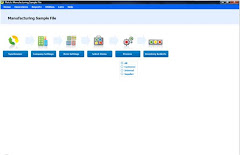Two of the most important decisions businesses make are how much inventory to order and how much to keep on hand. Unfortunately, most of today's inventory optimization software packages rely on cost based settings that are only partially capable of measuring true business performance. This post discusses the options to determine what point to order inventory with a focus on small businesses that use QuickBooks.
The current method to set or calculate reorder points in QuickBooks is manual. http://qbblog.ccrsoftware.info/2008/08/understanding-quickbooks-reorder-and-build-points/
http://qbblog.ccrsoftware.info/2008/08/calculating-quickbooks-reorder-points/
There are also many QuickBooks compatible products on the market that focus on the administrative tasks of managing inventory, however, only one optimizes inventory, Phitch OC 9.0.
Phitch OC 9.0 is the only software of its kind - it determines inventory alerts, reorder points, safety stocks, and order quantities at your point of maximum economic profit in order to optmize your company's investment in inventory. All other products on the market today rely on manual settings.
In order to maximize your wealth, Phitch OC 9.0 determines your actual demand and lead-time as well as your variability in demand and lead-time using data from QuickBooks while all other programs do not even consider these important factors.
Phitch OC 9.0 was designed to demonstrate its value proposition. Only Phitch OC 9.0 provides a report that measures the benefit obtained to validate the cost of acquisition as well as highlighting opportunities to the grow business by seizing demand variability options while driving out supply variability.
It is remarkable how much small businesses have needlessly tied up in cost in cash, for example in the case study highlighted below: Wholesale/Distributor Sample File
Customer Profile
- Wholesale/Distributor of lighting fixtures using QuickBooks® Premier with 5 employees
- $411k Revenue and $110k Net Income
- 50 inventory items
- $45k in Inventory, $130k in Cash, and $200k in Net Worth
Benefits of using Phitch OC 9.0
- $115k in wealth revealed (58% of the Net Worth!)
- Roughly 36% of items in surplus and 46% of items in shortage
- Opportunity to seize demand variability and opportunity to drive out supply variability
- Implementation time: Less than one hour

